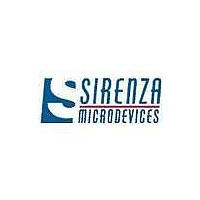SRF-2016 Sirenza Microdevices Inc, SRF-2016 Datasheet - Page 3

SRF-2016
Manufacturer Part Number
SRF-2016
Description
IC QUADRATURE DEMOD 16-TSSOP
Manufacturer
Sirenza Microdevices Inc
Datasheet
1.SRF-2016.pdf
(8 pages)
Specifications of SRF-2016
Function
Demodulator
Rf Frequency
200MHz ~ 600MHz
P1db
12dBm
Gain
-5dB
Noise Figure
30dB
Current - Supply
195mA
Voltage - Supply
4.75 V ~ 5.25 V
Package / Case
16-TSSOP
Lead Free Status / RoHS Status
Contains lead / RoHS non-compliant
Lo Frequency
-
Available stocks
Company
Part Number
Manufacturer
Quantity
Price
Company:
Part Number:
SRF-2016I
Manufacturer:
SIRENZA
Quantity:
2 972
Company:
Part Number:
SRF-2016Z
Manufacturer:
MOTOROLA
Quantity:
222
The SRF-2016 is a variable gain I-Q demodulator designed for use in receiver IF sections, as shown in the figure below. It con-
sists of five subcircuits: two cascaded switched gain stages, a matched pair of mixers, and a LO quadrature generator. This
part is also available in a higher frequency version, the SRF-1016.
The gain stages are broadband differential amplifiers each with a digital control pin to set the gain. The gain control pins act
independently of each other. Since the amplifiers have approximately the same gain, setting GC1 high and GC2 low results in
approximately the same gain as setting GC1 low and GC2 high. The former setting is preferred because it offers better noise
figure. The IF input is differential with internal bias circuitry to set the common mode voltage. The use of blocking capacitors to
facilitate AC coupling is highly recommended to avoid changing the common mode voltage. Either input may be driven single-
ended if the other input is connected to ground through an AC short such as a 1000pF capacitor. This typically results in
slightly lower input P
The two matched mixers are configured with the quadrature LO generator to provide in-phase and quadrature baseband out-
puts. These can be fed through ADCs to a DSP engine, or can be fed into a low frequency 90° hybrid for image rejection. Alter-
natively, the IF signal can be extracted from the BBI port by injecting DC into the LO port.
The LO and IF ports offer a differential 50 impedance. The package (and in the case of the input port, the parallel L-R net-
work) adds inductance that tends to degrade return loss. This can easily be matched out with a series capacitor. The 8.2pF
capacitor on the evaluation board is appropriate for 400MHz operation; larger capacitors should be used for lower frequen-
cies.
The SRF-2016 has high gain at UHF frequencies, so instability can result if there is poor power supply decoupling or undesired
coupling from the input to the output. The following considerations should be observed when laying out a PC board:
Follow the general layout of the evaluation board, keeping the power supply decoupling capacitors as close to the package as
possible. The back of the package, the two ground pins and the decoupling capacitors should connect directly to ground, pref-
erably to a large dedicated ground plane. Use the parallel L-R circuits on the input pins. Ensure that the input signal tracks are
routed far from the output tracks. The V
the specified decoupling capacitors.
The figures on page 4 illustrate a typical SRF-2016’s performance with respect to temperature. Note that these numbers
include the effect of the R-L network in the IF port.
The frequency response of the IF and LO ports is dominated by the L-R network on the input. When de-embedded, the gain and
P
The SRF-2016 features immunity from changes in LO power. The gain typically changes by less than 0.6dB over a 6dB range of
LO power. Also note the excellent I/Q balance, which typically falls within 0.15dB and 1.5° from 200MHz to 600MHz, and var-
ies less than 0.05dB and 0.5° over temperature (-40 to +85C).
DS101122
1dB
LNA
response is within 0.5dB from 200MHz to 600MHz.
Typical use for the SRF-2016 in a receiver
employing digital I/Q demodulation.
RF
Filter
1dB
.
IF
Filter
7628 Thorndike Road, Greensboro, NC 27409-9421 · For sales or technical
support, contact RFMD at (+1) 336-678-5570 or sales-support@rfmd.com.
SRF
2016
CC
pins are not internally connected, so all must be connected together externally with
BB
Filter
BB
Filter
I
ADC
Q
ADC
SRF-2016(Z)
3 of 8












